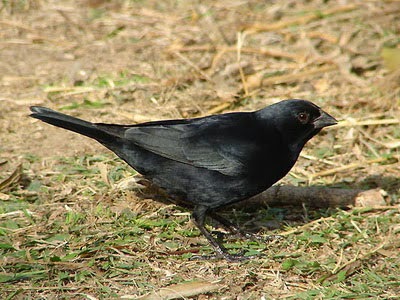 |
| Photo by Jorge Vicente (Reserva Ecológica Costanera Sur) |
Common name:
screaming cowbird (en); vira-bosta-picumã (pt); vacher criard (fr); tordo chillón (es); rotachsel-kuhstärling (de)
Taxonomy:
Order Passeriformes
Family Icteridae
Range:
This species is found from south-eastern Bolivia and Goiás in central Brazil, through Paraguay and Uruguay and into Argentina as far south as Río Negro and north-eastern Chubut.
Size:
These birds are 18-21 cm long and weigh 45-60 g.
Habitat:
The screaming cowbird was originally associated with grasslands and open woodlands, but is now mostly found in arable land and man-made pastures. They occur from sea level up to an altitude of 1.000 m.
Diet:
They feed mainly on insects and other arthopods, particularly beetles and ants, but also eat seeds.
Breeding:
These birds are apparently monogamous and breed in October-March. They are obligate brood parasites, meaning they never build their own nests, always laying their eggs on the nests of other birds. Most often they parasitize bay-winged cowbirds Agelaioides badius, but can also lay eggs on the nests of chopi blackbirds Gnorimopsar chopi and brown-and-yellow marshbirds Pseudoleistes virescens. Each female lays 2 eggs which are incubated by the host for 12-14 days. The chicks are fed by the host and fledge 12-16 days after hatching.
Conservation:
IUCN status – LC (Least Concern)
This species has a very large breeding range and is described as fairly common. The screaming cowbird has more than doubled the extent of its range in the last 50 years, probably due to conversion of natural vegetation into pastures and arable land.







